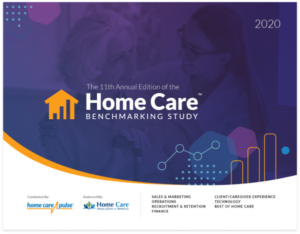“Without the data, you’re just another person with an opinion.”
W. Edwards Deming
By Stephen Tweed
One of the biggest differences between the leaders in the top 5% of home care, and those in the bottom quadrant, is their grasp of the numbers. As the leader of a successful home care business, you need to know your numbers. There are seven key numbers that tell us the financial health of your home care business.
If you really understand these seven numbers, and you compare your numbers to the Home Care Pulse benchmarking results, you will be in a great position to grow your business and make more money.
The Seven Key Numbers
- Total Revenue – this is the total number of dollars you take in from your home care and related services. As an owner or CEO, you will want to track your revenue on a weekly, monthly, and annual basis. You should be tracking your annual revenue growth year over year and comparing that to your peers in the industry. For this year’s study, the median annual revenue for all companies participating in the study is $1,815.000.
- Direct Cost of Care – this is the number of dollars you spend to put a caregiver into the home of a client. The expenses that are included in the direct cost of care are:
- Caregiver Wages
- Workers Compensation Insurance
- Caregiver Benefits (Health Insurance, etc.)
- Caregiver payroll taxes (FICA)
- Caregiver reimbursement – mileage, meals
- Caregiver ongoing training
- Other direct care expenses
For the median sized company this year, direct care expenses were 60.4% of revenue.
- Gross Margin – this is the difference between your Total Revenue and your Direct Cost of Care. The median for this study is 39.6%. There are only two ways to grow your Gross Margin. One is to raise prices. The other is to cut costs. Since we are in the middle of a caregiver recruiting and retention crisis, reducing caregiver wages or benefits is pretty much out of the question. That means if your Gross Margin is not where you want it, you need to figure out how to raise prices.
One “Rule of Thumb” we have learned over the years is that your bill rate to clients needs to be double your pay rate to caregivers. If you pay caregivers $12.00 per hour, you need to bill clients $24.00 per hour to earn a 40% gross Margin.
- Caregiver Recruitment and Retention Expenses – this is the total number of dollars you spend your job ads, background checks, on-boarding and initial training, and other expenses related to recruiting and retaining caregivers. In 2019 the median sized company spent 2.5% of revenue on recruiting and retention expenses.
- Sales and Marketing Expenses – this is the total number of dollars you spend on attracting and admitting new clients. This category includes advertising, Search Engine Optimization and social media, sales rep salaries, bonuses and benefits, and other marketing expenses. In 2019, the median sized company spent 4.4% of revenue on sales and marketing.
- Other Operating Expenses – this category includes all of the expenses to run your office including rent and utilities, office staff wages and benefits, software and computer hardware, travel, meals, and other operating expenses (Except owners’ compensation). One of the big line items I always look at is office staff wages and benefits. In 2019, Other Operating Expenses totaled 22.6% for franchises and 17.6% for independents. The difference here is that the typical franchise home care company paid 5% franchise royalty fee to their franchisor. This is included in the Other Operating Expenses category.
- Net Income from Operations Before Owner’s Compensation – this reflects the bottom line of your business before your own compensation and benefits. We use this number because there are so many ways for business owners to legitimately take money out of their businesses. In the 2020 report, we find the net income from operations to be 10.1% for franchises and 15.1% for independents. (The difference is the median 5% franchise royalty fees paid by franchisees to franchisors)
This net income number also gets you close to your agency’s EBITDA – earnings before interest, taxes, depreciation, and amortization. In the home care industry, the value of a company for use in buying or selling the company is based on a multiple of adjusted EBITDA.
Using the Numbers to Grow Your Business
What does your P&L have to do with your ability to grow your business?
The two big factors that affect your business growth are your caregiver recruiting and retention, and your sales and marketing process. How much you spend on recruiting and retention, and how you manage those processes will determine whether you have enough caregivers to grow your business.
How you spend your sales and marketing dollars, and how you manage your sales system will determine whether you are bringing in enough new clients.
Let me give you an example of how this can work. This past fall, we conducted in-person meetings of our four Home Care CEO Mastermind Groups. These are groups of ten to twelve similar sized companies who do not compete with one another. The groups come together regularly to share ideas, solve problems, and support one another. For our fall meetings, we gathered benchmarking data from each member company and displayed it on a spreadsheet. Each participant could see each company’s data.
Then we held in-depth conversations about where each company was spending money and what results they were getting. This led to more discussion around marketing techniques and recruitment methods. Our Mastermind Members are committed to our mantra, “What gets measures gets managed, what gets rewarded gets repeated.” Their discussions led to looking at other metrics they are tracking to learn more about their businesses, what works, and what doesn’t.
For example, they discussed their Employee Referral Programs, how much incentive they pay employees for caregiver referrals, and what their caregiver pipeline tracking looks like. They compared notes on how their own caregivers reacted to the bonus they receive for referring a friend to the company. Prior to this, we had conducted a “Best Caregiver Study”, and we learned what attracted the best caregivers to their company, what they like about working here, and why they stay. By comparing spending on recruiting and best caregiver feedback, members of the Mastermind can refine their processes and grow their businesses.
Using the Numbers to Improve Profitability
Most of us in the home care business are not here just for the money. We’re here because what we do makes a difference in the lives of our clients, their families, and our caregivers. However, as owners and key leaders, we all would like to make more money. Owners want to get an increased return on their investment of time, talent, and treasure in their business.
The Home Care Pulse Benchmarking Study gives us median numbers for home care companies in various categories. One of the new categories in 2019 is the “Masters”. These are companies with revenue of $5 million or more. The median size for companies in the Master class was $6,133,000 Their net income from operations was 14% for independents. That’s $858,620. What if you could improve your performance and earn net income of 15%? That’s another $122,660.
One Key Metric for Improved Growth and Profitability
As the folks at Home Care Pulse like to say, “Success leaves clues.” When we looked at the fastest growing and most profitable companies in our mastermind groups, one of the clues that stands out is average hours per client per week. We have seen that the home care companies with the highest average hours per clients per week are also the faster growing companies and the more profitable companies.
So how do you grow average hours per client? We’ve searched for clues to this question. Some of it has to do with your referral sources. We’ve been able to track clients with higher hours per week and longer lengths of stay to what we call the “Trusted Advisors,” which are bank trust officers, geriatric care managers, elder law and estate attorneys, and financial advisors. We’ve also tracked higher hours per week to companies that offer disease-specific programs such as Alzheimer’s and Dementia.
Study the Benchmarks and Compare Your Own Data
It is very clear to us that the largest, fastest growing, and most profitable home care companies are led by owners and CEOs who understand their financial performance, who have clear metrics for measuring performance, and who can discuss with their peers ways to improve growth and increase profitability. These are leaders who use the benchmarking data to help understand how their business is doing. You can too!
The 2021 study is now open. If you are a leader in home care, you will want to participate in this study. Download the Benchmarking Preparation Worksheet. Gather your data. Submit your data. Purchase a copy of the report. Compare your own data to the national benchmark data. Look for opportunities to improve your company’s performance.
Editor’s Note: This article was first published in the 2020 edition of the Home Care Benchmarking Study from Home Care Pulse.





